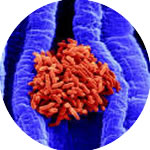Burkholderia pseudomallei
Burkholderia pseudomallei
(and closely related species)
- Organism Specific Information
- Concatenate Sequences
- Download Alleles
- Download ST’s
- Compare profile to refset
- Draw tree using own MLST data
- download as MS Access
- download as MS Excel
- B.pseudomallei Links
- eBURST V3
- Contact Curator
This site is hosted at Imperial College and development is funded by the Wellcome Trust.
For comments, queries, bugs or suggestions please contact David Aanensen
Burkholderia pseudomallei is a type of gram-negative motile rod-shaped bacteria of the genus Burkholderia. It is pathogenic to humans and animals and causes melioidosis.
Melioidosis occurs in some countries in Southeast Asia (India, Sri Lanka, Philippines, Indonesia), Central and South America, Australia and the island of Madagascar. The causative agent refers to the pathogenicity group II.
Story
Burkholderia pseudomallei was first isolated by the English captain Alfred Whitmore in Rangoon (Burma) in 1911 from opiate addicts who died from melioidosis and described in 1913 under the name Bacterium pseudomallei. In 1957, Haynes and Burkholder transferred the causative agent of melioidosis to the genus Pseudomonas. In 1973, Palleroni divided the genus Pseudomonas into 5 homology groups according to RNA-DNA hybridization, where Pseudomonas pseudomallei was included in the number of 7 species of group II. In 1993, a group of researchers from Yabuti, Kosako, Oyaizu, Yano, Hotta, Ezaki and Arakawa isolated the genus Burkholderia based on the analysis of 16S rRNA, DNA-DNA hybridization, and the composition of the cell wall fatty acids.
Biological properties
Burkholderia pseudomallei is gram-negative straight or slightly curved bacillus of a size 2-5 × 0.4-0.8 microns. It is movable and has several flagella. The bacterium does no form spore and capsules.
It is chemoorganoheterotroph, aerob, oxide positive, soil saprophyte. It lives everywhere in soil and groundwater.
Burkholderia pseudomallei is represented by two almost equal chromosomes. Chromosome I is a double-stranded ring DNA molecule with a length of 3988455 bp and contains 4085 genes. Chromosome II is represented by a smaller (3,100,794 bp) ring double-stranded DNA molecule and contains 3178 genes.
Pathogenicity
Burkholderia pseudomallei is the causative agent of natural focal and anthropurgical infections – melioidosis. Infection occurs from contact with contaminated soil and water. A case of prostatitis caused by B. pseudomallei is also known. The causative agent has weak adhesive properties, is able to activate Toll-like receptors.
Epidemiology
Melioidosis occurs in the form of sporadic cases and epidemic outbreaks in almost all continents. The source of infection is farm animals (pigs, cattle, horses), rodents (rats, mice), wild animals (hares, monkeys, kangaroos). Sick animals secrete a pathogen with feces, urine, pus. The transmission mechanism is fecal-oral. Transmission routes are food, water, contact-household, and contact mechanism is not excluded.
Prevention and control measures
- Destruction of rodents and blood-sucking insects;
- Preventing excrement of rats and mice from forage, feed, livestock products, water.
When melioidosis appears among animals, patients are isolated, rooms are cleaned and disinfected, measures are taken to prevent infection of people.
History reference
Melioidosis was first described in humans in 1912 in Rangoon by Whitemore and Krishnaswami. In 1913, Fletcher described the disease of guinea pigs and rabbits. In 1915, Babas isolated a culture of the causative agent of melioidosis from horses. Later it was isolated in sheep (in 1949) and goats (in 1954).


